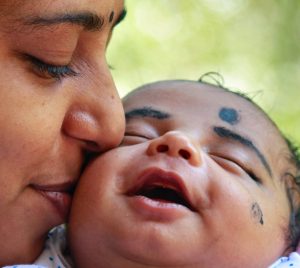Depression is a constant feeling of sadness and loss of interest, which keeps you from doing your normal activities. Different types of depression exist, with symptoms ranging from relatively minor to severe. Generally, depression does not result from a single event but from a mix of events and factors or from genetic factors.
Anxiety ~ Mixed anxiety-depressive disorder (MADD) is a new diagnostic category-defining patients who suffer from both anxiety and depressive symptoms of limited and equal intensity accompanied by at least some autonomic features.
…When your brain is in a constant state of stress or anxiety, the stem cells in your brain may begin to malfunction. When anxiety causes these cells to malfunction, the connection between the hippocampus and the amygdala becomes extremely rigid, rendering the brain to shut down its natural processing procedures.
Postpartum Depression…What Is It?
Postpartum Depression (PPD) is a type of depression that typically occurs after giving birth, although the onset can be up to a year after the birth. It is more serious than the “baby blues” as it can interfere with a new mother’s ability to function.  It’s important for new mothers and family members to be on the lookout for signs of postpartum depression. It is very treatable and early intervention can be key to helping mothers feel better as quickly as possible.
It’s important for new mothers and family members to be on the lookout for signs of postpartum depression. It is very treatable and early intervention can be key to helping mothers feel better as quickly as possible.
Symptoms…It is completely normal for new moms to feel tired, moody, or overwhelmed after giving birth. But when these symptoms interfere with a new mother’s ability to function and care for their new child, it can be a sign of postpartum depression.
Symptoms of PPD vary from person to person. And they may fluctuate on a daily basis. In general, here are some symptoms that mothers with this condition experience:

- Crying and unexplained feelings of sadness
- Exhaustion yet inability to sleep
- Eating too little or too much
- Intrusive thoughts about self-harm or harming the baby
- Unexplained aches and pains
- Sudden changes in mood
- Feelings of disconnect with the new baby and guilt about not experiencing joy
- Difficulty making decisions
- Lack of interest in previously enjoyed activities
- Irritability, Anxiety, and Anger that sometimes feel out of control
- Trouble concentrating, staying on task, and remembering things
- Feelings of hopelessness and helplessness
Diagnosis…
A physician or mental health professional can diagnose PPD. This diagnosis would be made after an interview and assessment.
Many physicians routinely ask new mothers questions about whether they’ve had thoughts of hurting themselves or their babies and whether they’re feeling down. This is part of the screening process for postpartum depression. Physicians may run some tests to rule out any health issues that may be contributing to symptoms. Thyroid conditions, for example, can cause depression. Once physical health issues have been ruled out, a diagnosis of postpartum depression might be made if the criteria are met.
How are these issues treated?
There are many different types of therapy to treat depression and other mood disorders. Finding out which type of psychotherapy is best for you will depend on a number of factors, including the severity of your symptoms, your own personal preferences, and your therapy goals.
The therapeutic modalities described below have evidence-based research supporting their benefits as treatments for depression:
 1.“Talk therapy” (catharsis) is one of the most effective ways to treat mild to moderate depression. What does it look like? It involves an individual and a counselor sitting together in a private, confidential, comfortable setting where the individual client, {after developing a relationship and rapport with the counselor}, is encouraged to tell their story…Counselors have formal training in a variety of techniques that they employ to help people recover from mental illness, resolve personal issues, and create positive changes in their lives.
1.“Talk therapy” (catharsis) is one of the most effective ways to treat mild to moderate depression. What does it look like? It involves an individual and a counselor sitting together in a private, confidential, comfortable setting where the individual client, {after developing a relationship and rapport with the counselor}, is encouraged to tell their story…Counselors have formal training in a variety of techniques that they employ to help people recover from mental illness, resolve personal issues, and create positive changes in their lives.
2. Cognitive Therapy~ at the heart of cognitive therapy is the idea that our thoughts can affect our emotions.
| For example, if we choose to look for the silver lining in every experience, we will more likely feel better than if we were to focus on the negative. |
Negative thoughts can contribute to and exacerbate depression. It’s hard to feel good when you’re stuck in a constant loop of negative thoughts. Cognitive therapy helps people learn to identify common patterns of negative thinking (known as cognitive distortions) and to turn those negative thought patterns into more positive ones, thus improving their mood.
3. Behavioral Therapy is similar to cognitive therapy, but instead of focusing on the negative thoughts that contribute to depression, behavioral therapy is centered on changing behaviors that affect emotions. Unlike the types of therapy that are rooted in insight (such as psychoanalytic and humanistic therapies), behavioral therapy is action-based. Because of this, behavioral therapy tends to be highly focused. The behavior itself is the problem and the goal is to teach people new behaviors to minimize or eliminate the issue.
4. Cognitive Behavioral Therapy ~ Because Cognitive Therapy and Behavioral Therapy work well together to treat depression and anxiety disorders, the two are often combined in an approach called Cognitive Behavioral Therapy (CBT).  It focuses on addressing both the negative thought patterns and the behaviors that contribute to depression.
It focuses on addressing both the negative thought patterns and the behaviors that contribute to depression.
A counselor may ask you to keep a journal to track the events of the week and any self-defeating and negative reactions to those events. Habitual negative responses to events are just one pattern of thinking you might address over the course of CBT. Other response patterns include all-or-nothing thinking and overgeneralization, which are two common Cognitive distortions.
Once you have learned how to recognize your response patterns, you will work with your counselor to learn new ways of thinking and ways of responding.
Like cognitive therapy and behavioral therapy, CBT is usually brief and goal-oriented. It generally involves between five to twenty structured sessions centered on addressing specific concerns.

